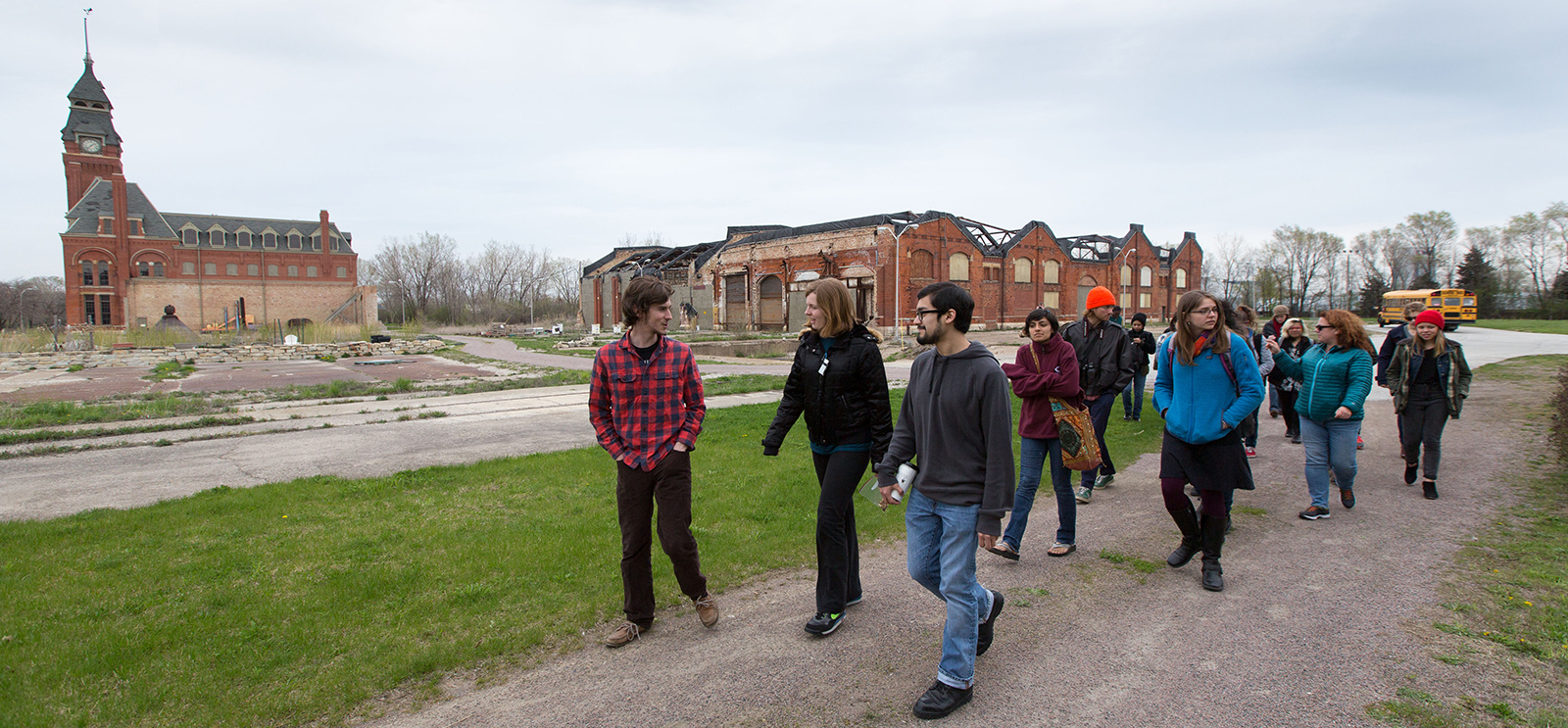
A Study Chicago excursion to Pullman.
Last spring the College ran the Study Chicago quarter for the first time. Inspired by the College’s Study Abroad offerings, the Study Chicago program included courses in history, literature, and public policy, as well as group excursions on Fridays.

“Pullman is now the utopia George Pullman wanted it to be,” says our docent, Jane Baxter of the Pullman State Historic Site. What she means is there’s a strong sense of community: there’s a wine club, a bridge club, a Scrabble club, a Morris dancing club. On the grounds of the old Pullman railcar factory, residents garden and keep bees.
Baxter, who fell in love with the area while doing archaeological work, moved here eight years ago. “There’s certainly a lot of dystopia in the utopia,” she admits. Pullman lacks such basic amenities as a grocery store, a coffee shop, or a bar (its founder would be pleased about that). There are few businesses of any kind.

It’s late April, two months after President Barack Obama designated Pullman—the first planned industrial community in the United States and scene of the violent 1894 strike—a national monument. But not much has changed yet. Baxter unchains the gate to the factory grounds and swings it open. You can’t go inside without a docent.
Chelsea Fine, a public policy major in the Class of 2016, is one of the few students in the Study Chicago group who’s already been to Pullman. Last year Fine visited on a class trip led by geography professor Michael Conzen, husband of Study Chicago professor emerita Kathleen Conzen.
Katherine Aanensen, a geography major who’s also Class of 2016, is seeing Pullman for the first time. “I’m freaked out by it,” she says.
[[{"type":"media","view_mode":"media_original","fid":"3254","attributes":{"alt":"","class":"media-image","height":"383","typeof":"foaf:Image","width":"500"}}]]
The group walks along the carriage path to the factory door. Inside workers made luxury railroad cars, popularly known as Pullman cars.
Baxter explains that the Pullman factory, which closed in 1950, burned in 1998. During the fire its clock tower—common in post-Industrial Revolution buildings “to remind you who owns your time”—functioned like a chimney. The factory buildings are now barren inside. The floor is sand and gravel, with a crop of low weeds where light streams in through grimy windows.

“I love buildings like this,” says Baxter. Soon the factory will be “sanitized,” she says, complete with “restrooms and movies and gift shops.”
George Pullman never lived in the town that bears his name, the group learns. He commuted from a mansion on Chicago’s Prairie Avenue in his own private Pullman car.
[[{"type":"media","view_mode":"media_original","fid":"3255","attributes":{"alt":"","class":"media-image","height":"383","typeof":"foaf:Image","width":"500"}}]]
The Pullman factory opened in 1881. By 1882 the workers were striking. “Almost every strike was over the foremen,” says Baxter: unskilled workers who supervised the skilled workers. These European craftsmen did the painting and metalwork “that made the Pullman cars so beautiful.”
Her archaeological research has revealed how dangerous the factory was. When workers were seriously injured, she says, their shirts would be cut off so they could be treated by the factory surgeon. From the number of shirt buttons she excavated, Baxter deduced that a worker was seriously injured every day.
[[{"type":"media","view_mode":"media_original","fid":"3256","attributes":{"alt":"","class":"media-image","height":"383","typeof":"foaf:Image","width":"500"}}]]
After the factory tour, the group makes a quick stop at the makeshift federal museum. The students watch a short low-budget documentary (“very funny for ’70s or ’80s reasons,” Aanensen says later), then fan out to explore the historic town.
Fine and Aanensen skirt the southern edge of the town’s central park, heading toward the church, which looks like it should be in Emerald City. It’s just brick, Fine points out, with greenstone cladding on the front.
She’s fascinated that the town was designed “to induce certain behaviors,” with the church at its center and no bars. Fine stops frequently to snap photos of the front doors of the row houses. As our docent explained, workers could not sit on the stoop, plant their own plants, or even hang a picture on the wall.

“We’re here at a really cool time,” Fine says.
“What’s going to happen to it now?” Aanensen wonders.
“I hope they don’t ruin it,” Fine says, echoing Baxter. “Make it cheesy.”
A few blocks south of the park, Aanensen and Fine spot three students coming out of a worker’s cottage. The owner, Ben, invites them in for an impromptu tour too.
The three-bedroom house is tiny and perfect, with its original stove and icebox (now used for storage). A sign outside explains that in 1900, the cabinet maker Chas Preikshot lived there with his wife and five children. Ben bought the house in 1979 for $17,500; at the time, he says, he wondered where he was going to get the 10 percent down payment.
[[{"type":"media","view_mode":"media_original","fid":"3257","attributes":{"alt":"","class":"media-image","height":"383","typeof":"foaf:Image","width":"500"}}]]
On the return trip to Hyde Park, Fine worries about her BA thesis. Many of her friends are well under way with theirs.
She had planned to write a thesis on Chicago’s public education system, with Chad Broughton, AM’97, PhD’01, who teaches the Study Chicago program’s public policy class, as her adviser. But this topic now seems both nebulous and overwhelming.
She thinks about Pullman and its uncertain future, now that it’s been named a national monument. What will happen to the tightly knit community there? Will people be able to stay? Will visitors make the trek to Pullman, with no CTA access and a Metra train that doesn’t stop unless you request it?
As one thought leads to another, Fine realizes maybe she does have a BA topic after all.
